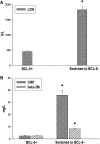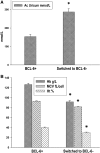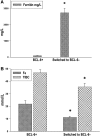Switching to BCL-6 Negativity in Relapsed Diffuse Large B Cell Lymphoma Correlated with More Aggressive Disease Course
- PMID: 25435726
- PMCID: PMC4243415
- DOI: 10.1007/s12288-014-0346-8
Switching to BCL-6 Negativity in Relapsed Diffuse Large B Cell Lymphoma Correlated with More Aggressive Disease Course
Abstract
Diffuse large B-cell lymphoma (DLBCL) is the most frequent, complex and heterogeneous lymphoma of adulthood. Heterogeneity is expressed at clinical, genetic, and molecular levels. It is known that BCL-6 expression is a favorable prognostic factor in DLBCL. However, the underlying mechanisms of BCL-6 expression in DLBCL relapse are not yet elucidated. Here, we present so far undescribed clinical phenomenon of switching BCL-6(+) protein expression into BCL-6(-) expression in 19 of 41 relapsed DLBCL patients. The switch in relapsed DLBCL was associated with more aggressive clinical course of the disease. Bone marrow infiltration and high IPI risk were more often present in BCL-6(-) patients. Significantly increased biochemical parameters, such as LDH, beta-2 macroglobulin, CRP, and ferritin have been found, as well as significantly decreased serum Fe, TIBC, and hemoglobin. A Ki-67 proliferation marker was considerably high in relapsed DLBCL, but without significant differences between BCL-6(+) and BCL-6(-) groups of patients. Thus, switching of the positive into negative BCL-6 expression during DLBCL relapse could be used as a prognostic factor and a valuable criterion for treatment decision.
Keywords: BCL6 switching; DLBCL; Prognosis; Relapse.
Figures





References
LinkOut - more resources
Full Text Sources
Other Literature Sources
Research Materials
Miscellaneous
